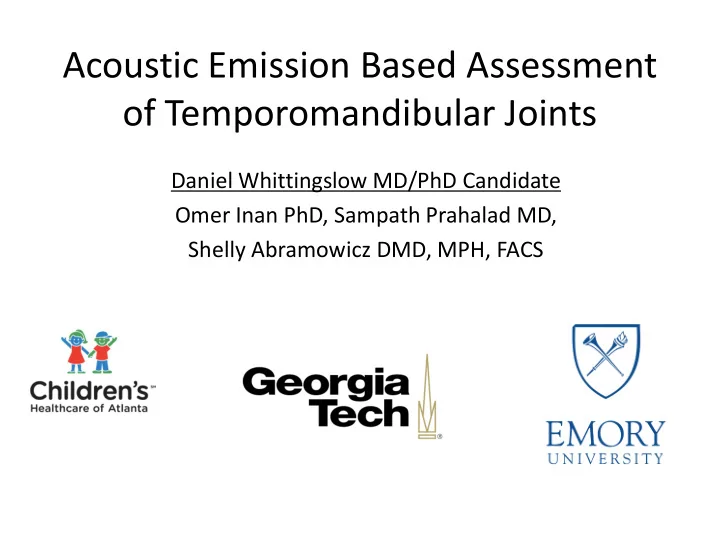

Acoustic Emission Based Assessment of Temporomandibular Joints Daniel Whittingslow MD/PhD Candidate Omer Inan PhD, Sampath Prahalad MD, Shelly Abramowicz DMD, MPH, FACS
BACKGROUND • Sounds from the TMJ are a common but poorly understood clinical sign. • The TMJ is difficult to examine, and diagnosis depends heavily on imaging. • Joint sounds have previously been shown to correlate with pathologies in the knee. 1 1. D. C. Whittingslow, et al., Using Knee Acoustical Emissions for Sensing Joint Health in Patients with Juvenile Idiopathic Arthritis: A Pilot Study , IEEE Sensors Journal
PURPOSE • Record and analyze TMJ sounds (acoustic emissions, AE). • To develop an instrumented headset for recording sounds from the TMJ. • To determine sound features that could help screen for pathologic conditions in the jaw.
MATERIALS AND METHODS Study design – Case-Control Inclusion criteria – Age 6-18 – No history of jaw disease, damage, or orthodontics – No history of craniofacial syndromes affecting the TMJ – No systemic disease affecting the TMJ Statistical Analysis – 2 tailed unmatched t-test (p <0.05)
MATERIALS AND METHODS • Ten maximal incisal openings (MIO) and lateral excursions while wearing headset 2 s TMJ sound recording headset is worn TMJ Sound Recording Headset with while performing jaw exercises. Integrated Contact Microphones
Study Demographics A TMJ + TMJ - Enrolled 3 male 5 male 12 female 15 female B Age (years) 14.3 11.9
RESULTS – Time Domain Signals Medial-Lateral Medial-Lateral A Open-Close Open-Close B TMJ Sounds No TMJ Sounds
DATA ANALYSIS METHOD: b-Value Analysis (i) Bandpass Filter (ii) Peak Detection Audio Units (mm/s 2 ) Audio Units (mm/s 2 ) Time (s) Time (s) (iv) log of Ordered Peaks (iii) Peaks w.r.t. Amplitude B-Value logN N Acoustical Emission Amplitude (dB) Acoustical Emission Amplitude (dB)
b-Value Comparison Medial-Lateral b-Values p=0.00014 No TMJ Sounds TMJ Sounds Open-Close b-Values p=0.01 No TMJ Sounds TMJ Sounds
CONCLUSIONS • Time-Domain AE signals are more chaotic in patients with TMJ sounds. • The b-Value showed significant differences between the two groups. • In the future, TMJ AEs could serve as a non-invasive biomarker of TMJ health.
Recommend
More recommend